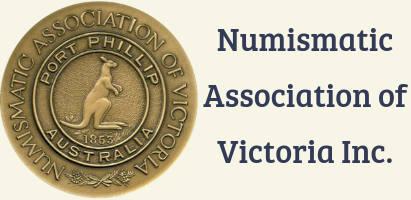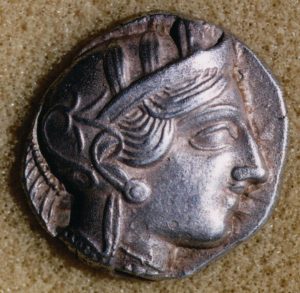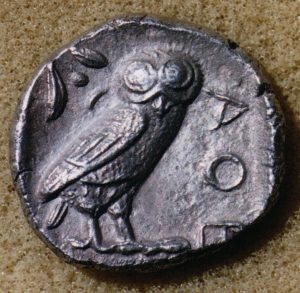The Owl of Athens – Possibly the Most Famous Trade Coin of the Ancient Greeks
The silver Athenian Tetradrachm (4 Drachms) widely circulated around the Mediterranean City States and beyond, from the early 5th century BC. It retained its “Archaic” design for nearly 300 years, even through the period of “Realistic – Classic” Art which is most associated with the Ancient Greeks. Its average weight is 17.5 g and it has an average diameter of 25 mm.
The obverse portrait of the helmeted Goddess Athena complements her Sacred Symbols on the reverse – a stylised owl and sprig of olive leaves with the first three letters of “Athens”. Additionally, on this Tetradrachm established in the early 5th century, is depicted a Crescent Moon – thought to commemorate the Victory over the Persians at Marathon, thus strengthening the power of the Greek City States. The origin of the basic design goes back to the mid 6th century BC, in a simpler form, soon after coinage was established in mainland Greece. A milestone in coin design is manifested in these early “Owls”, in that they represent some of the first coins to have a design stamped on both sides – rather than a design on the obverse only and a punch mark on the reverse. Quite early in their establishment these Athenian coins acquired the nickname “Owls”.
Most notable is the depiction of the Goddess Athena, the Patron of Athens, retaining an Archaic appearance – particularly in the “profile” treatment of the eye. This is strongly reminiscent of the much earlier artwork of ancient Egypt. The unchanged style of Trade Coins, of which this coin is one of the first examples, emphasises the importance of such stability. The same rule continued down to relatively recent times as trust in a coin’s bullion weight and fineness remained paramount for trade far and wide – guaranteed by a continuing familiar design. This rule only faded by the 20th century, along with the decreasing use of a precious metal as the principle payment medium.
From the inception of coinage in the 6th century BC, more than one weight standard was utilised. There were at least six main examples of this from trading centres around the Mediterranean – perhaps not surprising when considering their comparative isolation in ancient times. The “Attic” (Athenian) standard was approximately midway among these, which helped to bring it to a central position for trade in the Eastern Mediterranean. As Athens grew steadily in importance by the later fifth century, its coins increased in popularity (particularly the Tetradrachm).
The coinage weight standard was built around the Drachm of approximately 4.4 g of silver. This was divided into six Obols of 0.7 g. These in turn were divided into fractions down to a tiny 1/8 Obol of 0.09 g!
After the major threat from the Persian Empire was largely overcome by the beginning of the 4th century BC, the initially good supply of silver available to the Athenians ensured that prosperity from trade continued. Unfortunately, the unity of the southern City States of Greece did not last very long after the Persian threat was neutralised, so Athenian prosperity suffered accordingly. However the “Owls” continued to circulate widely, with some interruptions as the silver supply varied.
At last by the beginning of the 2nd century BC, the style of the famous Tetradrachm was “modernised” – but by then it no longer held the prominent position of a Trade Coin anyway. It had been largely supplanted by the vast Trade Coin supply of Alexander the Great and his successors. The last of the Athenian Tetradrachms faded from the scene by the late 1st century BC, well after Athens had become a vassal of the Roman Republic.


